Market Overview
The Global Radioimmunology Market is expected to be valued at
USD 645.2 million in 2025 and is expected to grow to
USD 1,054.5 million by 2034, registering a compound annual growth rate
(CAGR) of 5.6% from 2025 to 2034.
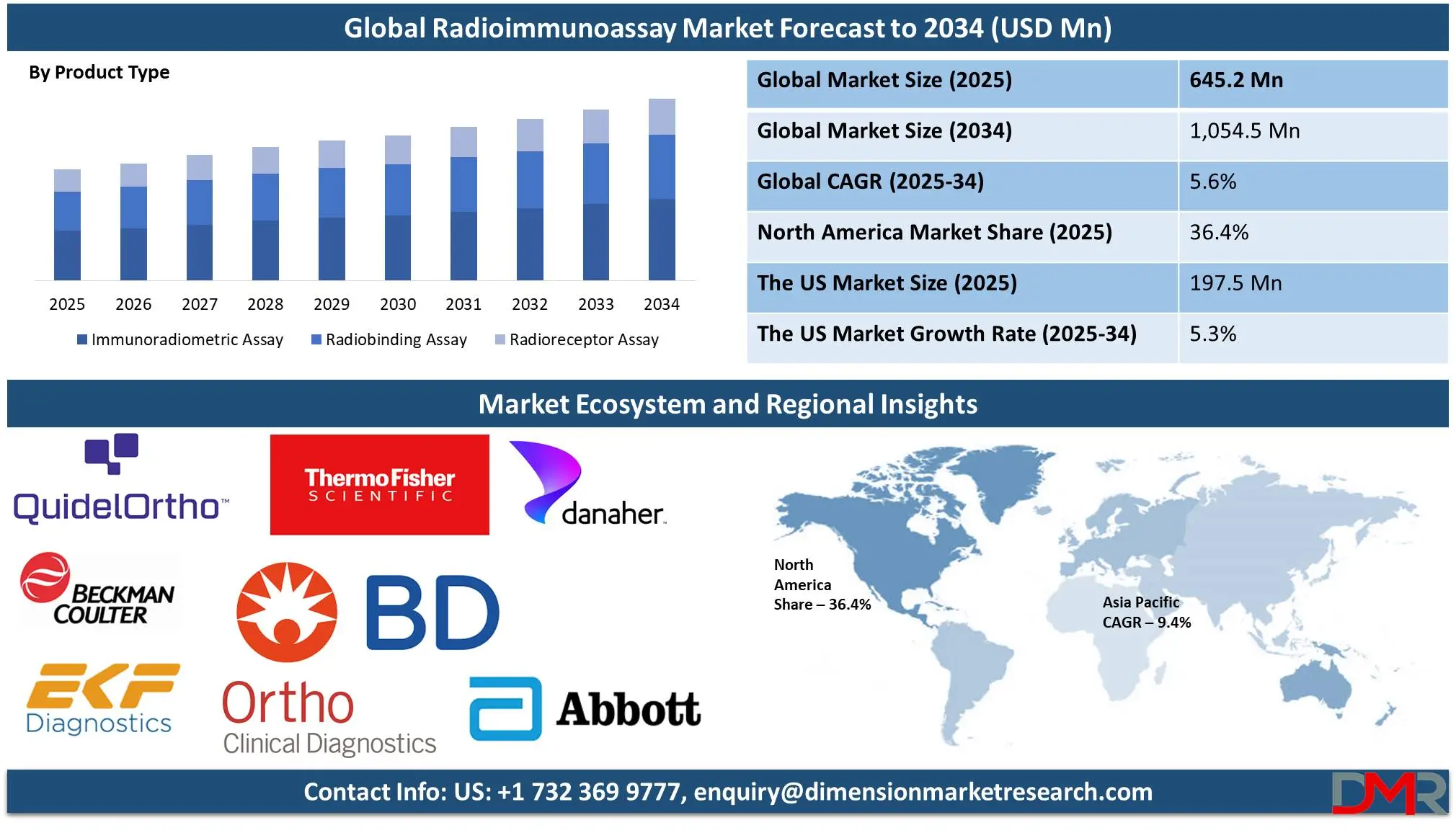
Radioimmunoassay (RIA) is a highly sensitive laboratory technique used to measure the concentration of antigens, hormones, or drugs in a sample using radioactive isotopes. It relies on the competition between a radioactively labeled substance and an unlabeled counterpart for binding to specific antibodies. The bound and free components are then separated, and radioactivity is measured to determine the concentration of the analyte. RIA is widely used in medical diagnostics, endocrinology, pharmacology, and research due to its precision, although concerns over radiation safety have led to the development of alternative non-radioactive immunoassays.
The global radioimmunoassay (RIA) market is primarily driven by the rising prevalence of chronic diseases such as cancer, diabetes, and endocrine disorders. These conditions require highly accurate hormone and biomarker detection for effective diagnosis and treatment, making RIA a crucial diagnostic tool in the healthcare industry. As the global burden of these diseases continues to rise, healthcare providers and researchers are increasingly relying on precise immunoassay techniques to improve patient outcomes. The growing aging population, which is more susceptible to chronic illnesses, further accelerates the demand for RIA in medical diagnostics.
Another key factor fueling market growth is the increasing emphasis on early disease detection. Early diagnosis plays a critical role in preventing disease progression and improving treatment efficacy. RIA offers high sensitivity and specificity, making it an essential tool for detecting low concentrations of antigens, hormones, and other biomolecules. The rising investment in healthcare infrastructure, particularly in emerging economies, is contributing to the wider adoption of advanced diagnostic techniques, including RIA. Additionally, the pharmaceutical and biotechnology industries extensively use RIA for drug development, therapeutic monitoring, and pharmacokinetic studies, further expanding the market demand.
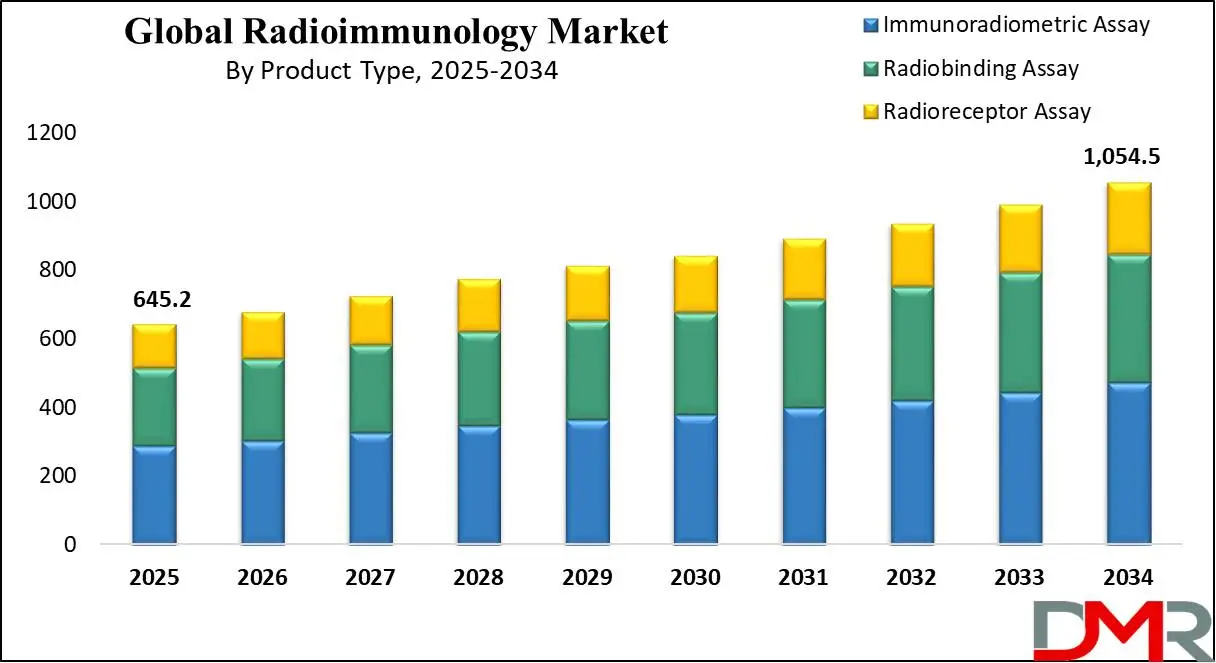
Radioimmunoassay has significant applications in forensic science and drug testing, particularly in detecting illicit substances and monitoring therapeutic drug levels. As governments and law enforcement agencies worldwide tighten regulations on drug testing, the demand for reliable and accurate testing methods continues to rise. However, despite its advantages, RIA faces challenges related to the handling and disposal of radioactive materials. The availability of alternative non-radioactive immunoassays, such as enzyme-linked immunosorbent assay (ELISA), also poses competition to market growth.
The US Radioimmunoassay Market
The US Radioimmunology market is projected to be valued at USD 197.5 million in 2025. It is expected to witness subsequent growth in the upcoming period as it holds USD 313.0 million in 2034 at a CAGR of 5.3%.
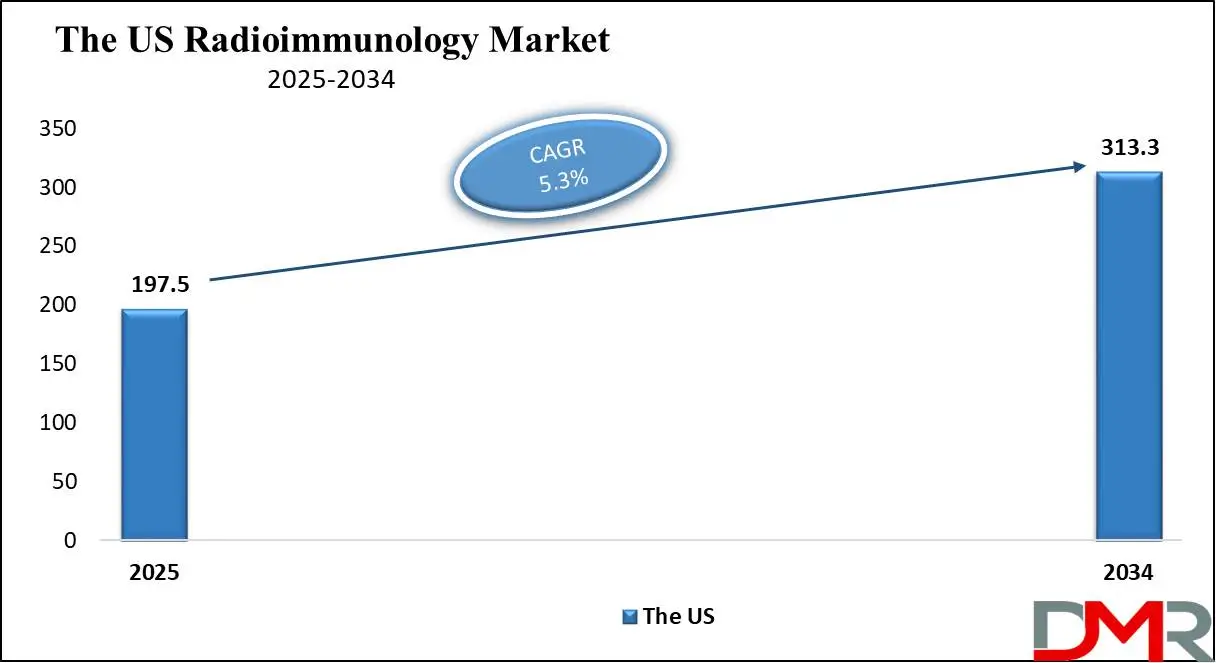
The U.S. radioimmunoassay (RIA) market is driven by the rising prevalence of chronic diseases, including cancer, diabetes, and hormonal disorders, which necessitate precise diagnostic tools. Increasing demand for early and accurate disease detection, especially in endocrinology and oncology, fuels market growth. Advancements in RIA technology enhance sensitivity and specificity, further boosting adoption. Additionally, expanding research in drug discovery and pharmaceutical applications, coupled with government support for diagnostic innovations, strengthens market demand despite the availability of alternative immunoassay techniques.
The integration of AI and machine learning in diagnostic procedures enhances data interpretation. There is also a rising preference for non-radioactive immunoassays due to stringent regulatory guidelines on radioactive materials. Moreover, increasing collaborations between research institutions and biotech firms are accelerating the development of novel RIA-based diagnostic applications, particularly in personalized medicine.
Radioimmunoassay Market: Key Takeaways
- Market Growth: The Global Radioimmunology Market is anticipated to expand by USD 376.8 million, achieving a CAGR of 5.6% from 2025 to 2034.
- Product Type Segment Analysis: The Immunoradiometric Assay (IRMA) segment is expected to dominate the Global Radioimmunoassay Market with the highest revenue share by the end of 2025.
- Sample Type Segment Analysis: Serum is expected to dominate the Radioimmunoassay Market with the largest revenue share in
- Application Segment Analysis: Oncology is expected to dominate the Radioimmunoassay (RIA) market with the highest revenue share in 2025.
- End User Segment Analysis: Hospitals are expected to dominate the radioimmunoassay market with the highest revenue share by the end of 2025.
- Regional Analysis: North America is predicted to lead the global Radioimmunology Market with a revenue share of 36.4% in 2025.
- Prominent Players: Some of the major key players in the Global Radioimmunology Market are PerkinElmer Inc., DiaSorin S.p.A., Beckman Coulter, Inc., and many others.
Radioimmunoassay Market: Use Cases
- Clinical Diagnostics: RIA is widely used in hospitals and diagnostic laboratories to detect and quantify hormones, drugs, and tumor markers in blood samples, aiding in the diagnosis and monitoring of various medical conditions such as thyroid disorders and diabetes.
- Pharmaceutical Research: Pharmaceutical companies utilize RIA for drug development and pharmacokinetic studies, allowing researchers to measure drug concentrations, assess drug metabolism, and evaluate therapeutic efficacy.
- Endocrinology Studies: RIA plays a crucial role in endocrinology by helping researchers measure hormone levels, such as insulin, cortisol, and growth hormones, to study hormonal imbalances and endocrine disorders.
- Veterinary Medicine: The technique is also applied in veterinary diagnostics to monitor hormone levels in animals, detect infectious diseases, and assist in reproductive health assessments for livestock and pets.
Radioimmunoassay Market: Stats & Facts
- Radioimmunoassay (RIA) is a highly sensitive laboratory technique used to measure hormones, drugs, and other biological molecules in blood or other fluids. It relies on antigen-antibody interactions and the detection of radioactively labeled substances.
- RIA was developed by Rosalyn Yalow and Solomon Berson in the 1950s, revolutionizing medical diagnostics. Rosalyn Yalow was awarded the Nobel Prize in Physiology or Medicine in 1977 for her contributions, becoming the second woman to receive this prestigious award in the field.
- RIA is extremely sensitive and capable of detecting substances at picogram (10⁻¹² g) or nanogram (10⁻⁹ g) concentrations. It is also highly specific, as antibodies selectively bind to their target molecules, minimizing interference from other substances in biological samples.
- Due to potential radiation hazards, laboratories using RIA must follow stringent safety protocols. Regulatory bodies such as the International Atomic Energy Agency (IAEA) and the U.S. Food and Drug Administration (FDA) oversee its safe usage, handling, and waste disposal.
- The rising incidence of chronic diseases, including cancer, is a major factor driving the demand for advanced diagnostic techniques like RIA. With nearly 1.9 million new cancer cases in the United States in 2022, the need for precise diagnostic tools is increasing, positioning RIA as a critical technology in disease management.
Radioimmunoassay Market: Market Dynamic
Driving Factors in the Radioimmunoassay Market
Increasing Prevalence of Chronic DiseasesThe rising incidence of chronic diseases such as cancer, cardiovascular diseases, and autoimmune disorders is a major driving force in the radioimmunoassay (RIA) market. Early and accurate diagnosis is critical for effective disease management, and RIA provides high sensitivity and specificity in detecting disease-related biomarkers. As healthcare systems focus on preventive and early diagnostic measures to reduce morbidity and mortality rates, the demand for RIA-based diagnostic solutions continues to grow. The need for timely detection and targeted treatment strategies further fuels the adoption of RIA in clinical diagnostics and research applications.
Advancements in RIA Technology
Technological innovations in RIA, including automation, improved reagent sensitivity, and multiplex assays, have significantly enhanced the assay’s efficiency and diagnostic capabilities. Automated RIA systems streamline sample preparation, data analysis, and reporting, reducing turnaround times and minimizing human error. The introduction of multiplex RIA assays allows simultaneous detection of multiple analytes, providing comprehensive diagnostic insights. These advancements increase laboratory efficiency, making RIA more accessible and cost-effective. As research continues to refine RIA methodologies, its applications in clinical and pharmaceutical settings are expanding, further driving market growth.
Restraints in the Radioimmunoassay Market
High Cost of Installation and Maintenance
The high cost associated with the installation and maintenance of radioimmunoassay (RIA) kits poses a significant challenge for market growth. Advanced RIA techniques require specialized equipment, skilled personnel, and stringent safety measures, all of which contribute to increased expenses. Additionally, continuous advancements in life sciences drive innovation in RIA techniques, further raising costs. These high expenses make RIA less accessible to smaller laboratories and research institutions, limiting its widespread adoption. As a result, the growing financial burden on healthcare and research organizations is expected to hinder the expansion of the global radioimmunoassay market.
Short Shelf-Life of Radiolabeled Compounds
Radiolabeled compounds used in radioimmunoassay degrade over time due to radiolytic decomposition, which occurs faster than in non-radioactive substances. This short shelf-life necessitates strict storage conditions and continuous replenishment, adding to operational costs. Laboratories and research centers must invest in specialized storage facilities and follow rigorous safety protocols to prevent contamination and ensure accuracy. The need for frequent reordering of these compounds also leads to logistical challenges and increased expenses. This limitation not only affects the reliability of RIA but also restrains its adoption in diagnostic and research applications, hampering the overall market growth.
Opportunities in the Radioimmunoassay Market
Expansion in Personalized Medicine
The increasing adoption of personalized medicine presents a significant opportunity for the RIA market. RIA plays a crucial role in identifying disease-specific biomarkers that help tailor treatments to individual patient profiles. By analyzing genetic and biochemical markers, clinicians can optimize therapy selection, monitor disease progression, and predict patient responses to treatments. As healthcare providers shift toward precision medicine approaches, the demand for highly sensitive and specific diagnostic tools like RIA is expected to grow, leading to increased market penetration and expanded applications in personalized healthcare solutions.
Growing Applications in Drug Development and Research
RIA’s high specificity and sensitivity make it a valuable tool in pharmaceutical research and drug development. It is widely used for therapeutic drug monitoring, hormone analysis, and detecting biomarkers in preclinical and clinical trials. As pharmaceutical companies invest in the development of targeted therapies and biologics, RIA’s role in assessing drug efficacy and safety becomes increasingly important. The growing demand for novel drug candidates and biomarker-based diagnostics offers lucrative opportunities for RIA manufacturers and researchers to innovate and expand their market presence in the pharmaceutical and biotechnology industries.
Trends in the Radioimmunoassay Market
Advancements in Automation and AI-driven RIA Platforms
The radioimmunoassay (RIA) market is witnessing a shift toward automated platforms and AI-driven data interpretation, significantly enhancing test accuracy and efficiency. Automation minimizes human errors, streamlines workflows, and reduces turnaround times, making RIA a more attractive option for clinical diagnostics. AI-driven analysis enables precise biomarker detection, fostering applications in precision medicine and personalized healthcare. These advancements are particularly beneficial in hormone analysis and cancer diagnostics, where sensitivity and specificity are crucial. As laboratories and diagnostic firms invest in next-generation RIA kits, automation, and AI integration will continue to shape the market, offering improved performance and reliability.
Expansion of RIA in Telehealth and Home Diagnostics
The growing adoption of telehealth and home-based diagnostic services is driving the demand for convenient and accurate testing methods, positioning RIA as a key player in this transformation. RIA-based laboratory tests are becoming increasingly popular for hormone level monitoring, infectious disease screening, and early cancer detection. The push for at-home sample collection and remote test analysis is accelerating RIA adoption due to its high sensitivity and specificity. Additionally, advancements in low-radiation and eco-friendly RIA technologies are making it a safer and more sustainable option. As home healthcare expands, RIA is expected to play a crucial role in decentralized diagnostics.
Radioimmunoassay Market: Research Scope and Analysis
By Product Type Analysis
The Immunoradiometric Assay (IRMA) segment is expected to dominate the Global Radioimmunoassay Market with the highest revenue share by the end of 2025, due to its high sensitivity and specificity in detecting antigens and antibodies. Unlike traditional radioimmunoassays, IRMA uses labeled antibodies, enhancing accuracy and minimizing cross-reactivity. This method is widely utilized in diagnosing hormonal disorders, infectious diseases, and cancer biomarkers, driving its adoption. Additionally, increasing demand for precise diagnostic tests, the growing prevalence of chronic diseases, and advancements in immunoassay techniques contribute to its market leadership. The ability to deliver rapid and reliable results further solidifies IRMA’s leading position in the market.
The Radiobinding Assay (RBA) segment is anticipated to grow at a faster rate due to its crucial role in studying ligand-receptor interactions and drug development. This technique is highly valued in pharmaceutical research for assessing binding affinities and receptor activities, essential for drug discovery and development. Additionally, the rising prevalence of neurological and endocrine disorders necessitates advanced diagnostic tools, further boosting RBA adoption. Increasing investments in precision medicine and targeted therapies also contribute to its rapid growth. As demand for receptor-based diagnostics and therapeutics rises, RBAs are expected to witness substantial market expansion.
By Sample Type Analysis
Serum is expected to dominate the Radioimmunoassay Market with the largest revenue share in 2025 due to its widespread use in clinical diagnostics and research. It provides a stable and concentrated sample for detecting hormones, drugs, and disease markers with high sensitivity and specificity. Serum samples are preferred in immunoassays as they lack clotting factors, reducing interference in testing. Additionally, the increasing prevalence of chronic diseases, such as cancer and endocrine disorders, is driving the demand for serum-based assays. Established laboratory protocols and the extensive use of serum in hospitals and diagnostic centers further solidify its dominance in the market.
Plasma is anticipated to grow at the highest CAGR due to the rising adoption of plasma-based immunoassays in diagnostic applications. Unlike serum, plasma retains clotting factors and other biomolecules, making it suitable for a broader range of assays. The growing demand for early disease detection and personalized medicine is driving the adoption of plasma samples in research and clinical settings. Additionally, advancements in plasma-based testing for infectious diseases, oncology, and biomarker discovery are further fueling its growth. The increasing preference for liquid biopsy techniques and non-invasive diagnostic solutions is expected to accelerate plasma’s market expansion.
By Application Analysis
Oncology is expected to dominate the Radioimmunoassay (RIA) market with the highest revenue share in 2025, due to the rising global prevalence of cancer and the critical need for precise biomarker detection. RIA plays a crucial role in early cancer diagnosis, treatment monitoring, and recurrence detection by measuring tumor markers with high sensitivity. The growing adoption of targeted therapies and personalized medicine further drives demand for accurate diagnostic tools like RIA. Additionally, advancements in biotechnology and increasing investments in cancer research enhance the development of novel radioimmunoassays, solidifying oncology’s position as the leading application segment in the market.
The infectious disease segment is expected to grow at a faster rate in the Radioimmunoassay market due to the rising incidence of infectious diseases, particularly in developing regions. The increasing demand for rapid, sensitive, and specific diagnostic tests fuels RIA adoption for detecting viral and bacterial infections. The global threat of emerging diseases, antimicrobial resistance, and pandemic outbreaks necessitates accurate diagnostic methods. Additionally, growing healthcare infrastructure, government initiatives for disease control, and advancements in immunodiagnostics contribute to the segment’s rapid expansion, making infectious disease diagnostics a key area of growth in the RIA market.
By End User Analysis
Hospitals are expected to dominate the radioimmunoassay market with the highest revenue share by the end of 2025, due to the increasing number of patients requiring precise diagnostic tests for various diseases, including chronic and infectious conditions. The rising prevalence of cancer, cardiovascular diseases, and hormonal disorders has fueled the demand for accurate and reliable diagnostic solutions, which hospitals can provide due to their well-equipped laboratories and trained medical professionals. Additionally, hospitals have higher patient footfall, advanced healthcare infrastructure, and access to cutting-edge radioimmunoassay technologies, further solidifying their market dominance. The growing focus on personalized medicine and early disease detection also contributes to the strong presence of hospitals in this market.
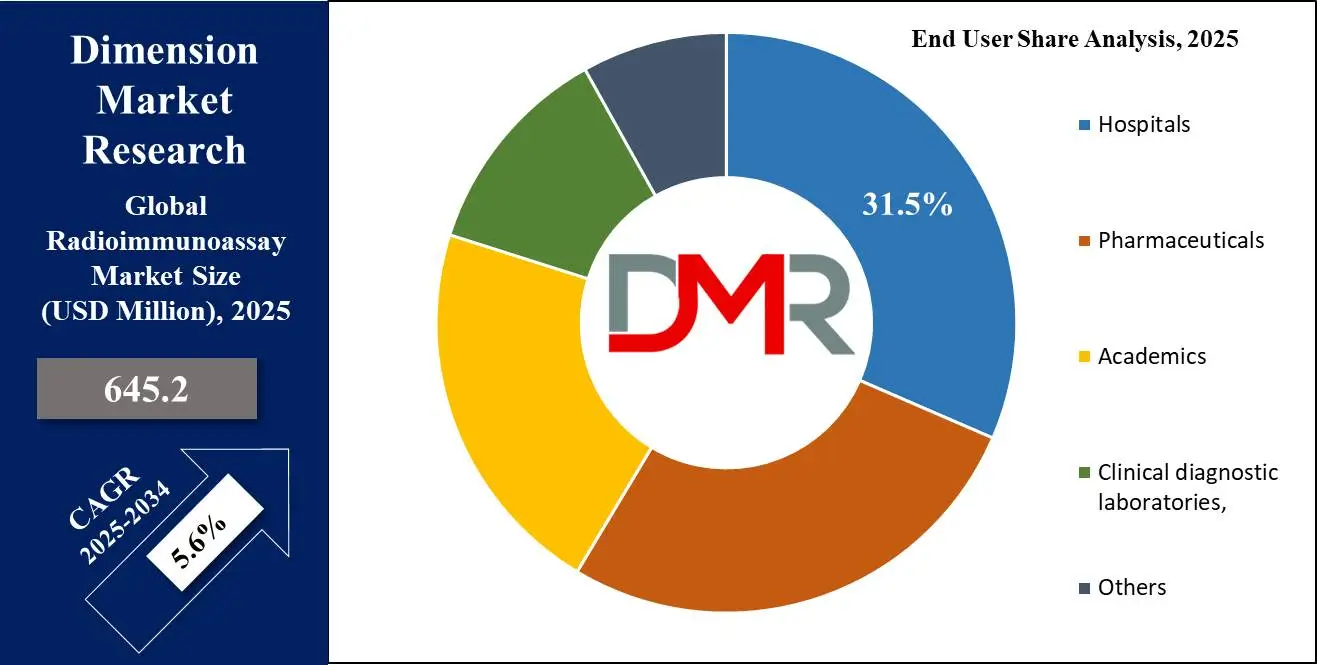
The pharmaceutical sector is expected to grow at a faster rate in the radioimmunoassay market due to increasing investment in drug development and biomarker research. As precision medicine gains momentum, pharmaceutical companies are leveraging radioimmunoassay techniques to enhance drug discovery, improve clinical trials, and develop targeted therapies. The rising prevalence of chronic diseases and the demand for highly specific diagnostic tools have driven pharmaceutical firms to integrate advanced radioimmunoassay solutions into their research processes. Additionally, regulatory support for innovative biologics and personalized treatment approaches has further accelerated the adoption of radioimmunoassay technology in the pharmaceutical industry.
The Radioimmunoassay Market Report is segmented based on the following
By Product Type
- Immunoradiometric Assay
- Radiobinding Assay
- Radioreceptor Assay
By Sample Type
- Serum
- Plasma
- Urine
- Saliva
By Application
- Oncology
- Cardiology
- Endocrinology
- Infectious Disease
- Autoimmune Disease
- Therapeutic Drug Monitoring
- Others
By End User
- Hospitals
- Pharmaceuticals
- Academics
- Clinical diagnostic laboratories,
- Others
Regional Analysis
Region with the largest Share
North America is expected to lead the global radioimmunoassay market with a revenue
share of 36.4% in 2025, due to its advanced healthcare infrastructure, high healthcare spending, and strong presence of key market players. The region’s high disposable income enables greater adoption of advanced diagnostic techniques, while the increasing prevalence of chronic diseases such as cancer and hormonal disorders further drives demand. Additionally, continuous research and development efforts, along with favorable government initiatives supporting diagnostic advancements, contribute to market growth. The presence of well-established laboratories, strong regulatory frameworks, and growing awareness about early disease detection further solidify North America's dominant position in the global market.
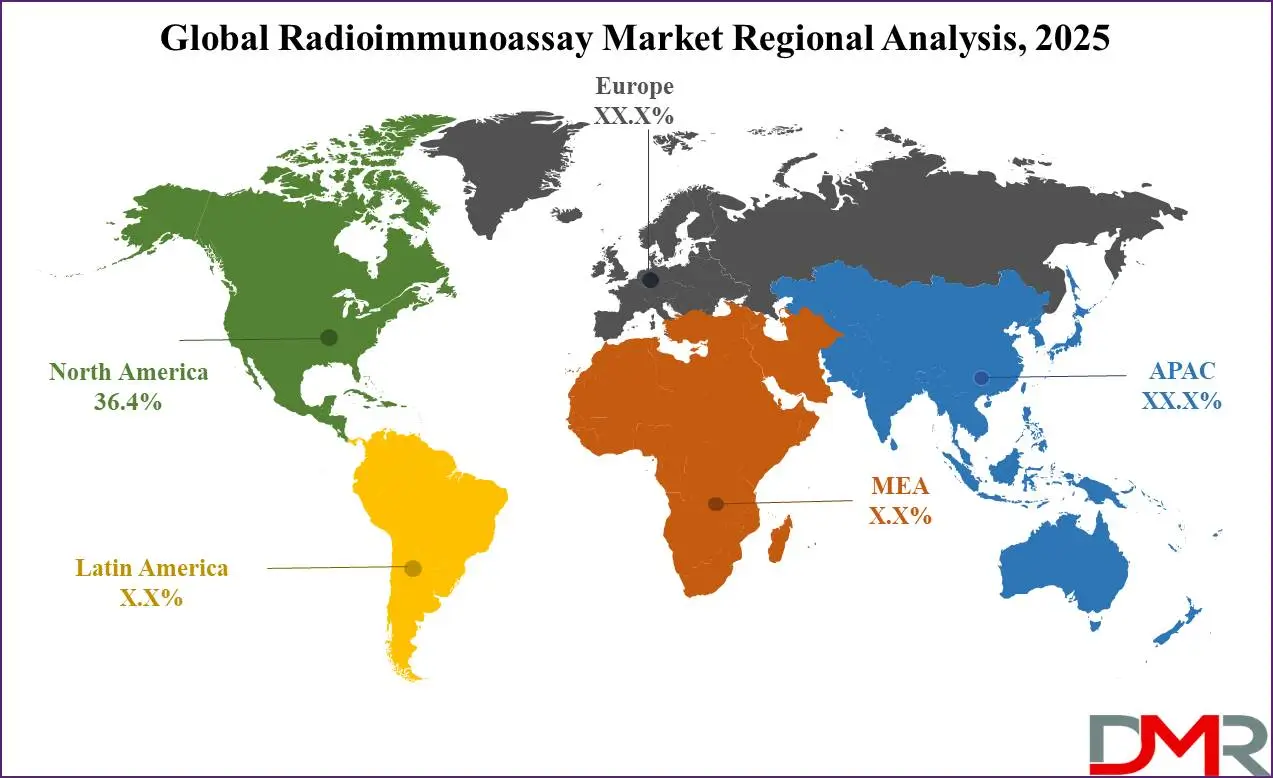
Region with Highest CAGR
The Asia-Pacific (APAC) region is expected to witness the fastest growth in the radioimmunoassay market due to increasing healthcare expenditure, improving access to medical facilities, and a rapidly growing population. Rising awareness about early disease diagnosis and the growing prevalence of chronic conditions, including cancer and infectious diseases, are fueling demand. Additionally, government initiatives promoting healthcare advancements and expanding biotechnology research contribute to market expansion. The presence of emerging economies such as China and India, where healthcare infrastructure is evolving rapidly, further accelerates growth. Furthermore, increasing collaborations between global market players and regional institutions drive technological adoption in the region.
By Region
North America
Europe
- Germany
- The U.K.
- France
- Italy
- Russia
- Spain
- Benelux
- Nordic
- Rest of Europe
Asia-Pacific
- China
- Japan
- South Korea
- India
- ANZ
- ASEAN
- Rest of Asia-Pacific
Latin America
- Brazil
- Mexico
- Argentina
- Colombia
- Rest of Latin America
Middle East & Africa
- Saudi Arabia
- UAE
- South Africa
- Israel
- Egypt
- Rest of MEA
Competitive Landscape
Key players in the Radioimmunoassay Market are actively working on developing innovative products and advanced technologies to keep up with the changing demands of the industry. Companies are focusing on enhancing the accuracy, sensitivity, and specificity of their assays through continuous research and development efforts. This allows them to improve diagnostic capabilities and provide more reliable results for medical and research applications.
To strengthen their market position, leading companies are forming strategic collaborations and partnerships. By working together, they can leverage each other’s strengths, expand their product offerings, and reach a broader customer base. These partnerships also facilitate knowledge sharing and technological advancements, driving overall market growth.
Additionally, many companies are exploring mergers and acquisitions as a strategy to expand their capabilities and increase their market share. By acquiring smaller firms or complementary businesses, they can integrate new technologies, improve operational efficiency, and strengthen their presence in key regions.
Some of the prominent players in the global Radioimmunoassay are
- QuidelOrtho Corporation
- HoffmannLa Roche Ltd.
- Ortho Clinical Diagnostics
- Becton, Dickinson and Company
- Thermo Fisher Scientific Inc.
- EKF Diagnostics Holdings plc
- Beckman Coulter, Inc.
- Danaher Corporation
- PerkinElmer Inc.
- BioRad Laboratories, Inc.
- Agilent Technologies, Inc.
- Siemens Healthineers
- DiaSorin S.p.A.
- Sysmex Corporation
- Abbott Laboratories
- Montreal Biotech
- DIAsource
- Abbexa
- IBL International GmbH
- Creative Biolabs
- MP BIOMEDICALS
- Other Key Players
Recent Developments
- In June 2023, DiaSorin introduced its LIAISON B·R·A·H·M·S MR-proADM immunodiagnostic assay in all regions that recognize the CE Mark.
- In May 2023, the private biotech company Freenome acquired Oncimmune Ltd, a UK-based leader in global immunodiagnostics development. This acquisition provides Freenome with valuable clinical and commercial assets, strengthening its efforts in frontline screening.
- In April 2022, Merck, a leading science and technology company, introduced several organizational changes and a new operating model to drive long-term growth in its life sciences sector and better meet evolving customer needs. These initiatives have contributed to the expansion of its life sciences business.
- In June 2022, EUROIMMUN, a subsidiary of PerkinElmer, Inc., launched two CE-marked assays—the Anti-SARS-CoV-2 RBD ChLIA (IgG) and the Anti-SARS-CoV-2 Omicron ELISA (IgG). These test systems detect IgG antibodies against SARS-CoV-2 and are available in regions recognizing the CE mark, supporting the company’s market expansion.
Report Details
| Report Characteristics |
| Market Size (2025) |
USD 645.2 Mn |
| Forecast Value (2034) |
USD 1,054.5 Mn |
| CAGR (2025-2034) |
5.6% |
| Historical Data |
2019 – 2024 |
| The US Market Size (2025) |
USD 197.5 Mn |
| Forecast Data |
2025 – 2033 |
| Base Year |
2024 |
| Estimate Year |
2025 |
| Report Coverage |
Market Revenue Estimation, Market Dynamics, Competitive Landscape, Growth Factors and etc. |
| Segments Covered |
By Product Type (Immunoradiometric Assay, Radiobinding Assay, and Radioreceptor Assay), By Sample Type (Serum, Plasma, Urine, and Saliva), By Application (Oncology, Cardiology, Endocrinology, Infectious Disease, Autoimmune Disease, Therapeutic Drug Monitoring, Drug Abuse, and Others), By End User (Hospitals, Pharmaceuticals, Academics, Clinical diagnostic laboratories, and Others) |
| Regional Coverage |
North America – The US and Canada; Europe – Germany, The UK, France, Russia, Spain, Italy, Benelux, Nordic, & Rest of Europe; Asia- Pacific– China, Japan, South Korea, India, ANZ, ASEAN, Rest of APAC; Latin America – Brazil, Mexico, Argentina, Colombia, Rest of Latin America; Middle East & Africa – Saudi Arabia, UAE, South Africa, Turkey, Egypt, Israel, & Rest of MEA
|
| Prominent Players |
QuidelOrtho Corporation, Hoffmann-La Roche Ltd., Ortho Clinical Diagnostics, Becton, Dickinson and Company, Thermo Fisher Scientific Inc., EKF Diagnostics Holdings plc., Beckman Coulter, Inc., Danaher Corporation, PerkinElmer Inc., BioRad Laboratories, Inc., Agilent Technologies, Inc., Siemens Healthineers, DiaSorin S.p.A., Sysmex Corporation, Abbott Laboratories, Montreal Biotech, DIAsource, Abbexa, IBL International GmbH, Creative Biolabs, MP BIOMEDICALS, and Other Key Players |
| Purchase Options |
We have three licenses to opt for: Single User License (Limited to 1 user), Multi-User License (Up to 5 Users) and Corporate Use License (Unlimited User) along with free report customization equivalent to 0 analyst working days, 3 analysts working days and 5 analysts working days respectively. |
Frequently Asked Questions
The Global Radioimmunology Market size is estimated to have a value of USD 645.2 million in 2025 and is expected to reach USD 1,054.5 million by the end of 2034.
North America is expected to be the largest market share for the Global Radioimmunology Market with a share of about 36.4% in 2025.
Some of the major key players in the Global Radioimmunoassay Market are PerkinElmer Inc., DiaSorin S.p.A., Beckman Coulter, Inc., and many others.
The market is growing at a CAGR of 5.6 percent over the forecasted period.
The US Radioimmunology Market size is estimated to have a value of USD 197.5 million in 2025 and is expected to reach USD 313.0 million by the end of 2034.